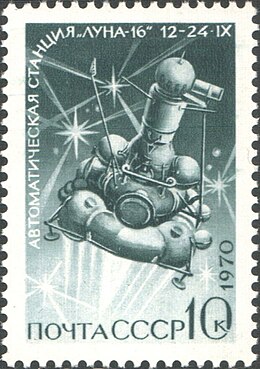 Stamp depicting a Ye-8-5 bus spacecraft | |
| Mission type | Lunar sample return |
|---|---|
| Operator | Soviet space program |
| COSPAR ID | 1969-058A |
| SATCAT no. | 4036 |
| Mission duration | 8 days achieved |
| Spacecraft properties | |
| Bus | Ye-8-5 |
| Manufacturer | GSMZ Lavochkin |
| Launch mass | 5,667 kg (12,494 lb)[1] |
| Dry mass | 2,718 kg (5,992 lb)[2] |
| Start of mission | |
| Launch date | 13 July 1969, 02:54:42 UTC[3] |
| Rocket | Proton-K/D |
| Launch site | Baikonur 81/24 |
| End of mission | |
| Destroyed | 21 July 1969, 15:51 UTC |
| Orbital parameters | |
| Reference system | Selenocentric |
| Lunar orbiter | |
| Orbital insertion | 17 July 1969, 10:00 UTC |
| Lunar impact (failed landing) | |
| Impact date | 21 July 1969, 15:51 UTC |
| Impact site | 17°N 60°E / 17°N 60°E[1] |
| Instruments | |
| |
Luna 15 was a robotic space mission of the Soviet Luna programme, that was in lunar orbit together with the Apollo 11 Command module Columbia.
On 21 July 1969, while Apollo 11 astronauts finished the first human moonwalk, Luna 15, a robotic Soviet spacecraft in lunar orbit at the time, began its descent to the lunar surface. Launched three days before the Apollo 11 mission, it was the second Soviet attempt to bring lunar soil back to Earth with a goal to outstrip the US in achieving a sample return in the Moon race. The previous mission, designated E-8-5-402, launched 14 June 1969, did not achieve Earth orbit because the third stage of its launch vehicle failed to ignite. The Luna 15 lander crashed into the Moon at 15:50 UT, hours before the scheduled American lift off from the Moon.[4]
Mission
[edit]Luna 15 was capable of studying circumlunar space, the lunar gravitational field, and the chemical composition of lunar rocks. It was also capable of providing lunar surface photography. Luna 15 was placed in an intermediate Earth orbit after launch and was then sent toward the Moon. After a mid-course correction the day after launch, Luna 15 entered lunar orbit at 10:00 UT on 17 July 1969. The spacecraft remained in lunar orbit for two days while controllers checked all on-board systems and performed two orbital manoeuvres.
After completing 86 communications sessions and 52 orbits of the Moon at various inclinations and altitudes, it began its descent. Astronauts Neil Armstrong and Buzz Aldrin had already set foot on the Moon when Luna 15 fired its main retrorocket engine to initiate descent to the surface at 15:47 UT on 21 July 1969. Transmissions ceased four minutes after de-orbit, at a calculated altitude of 3 kilometres (1.9 mi). The spacecraft had probably crashed into the side of a mountain.
Impact coordinates were 17° north latitude and 60° east longitude, in Mare Crisium. Luna's impact site is some 554 kilometres (344 mi) north-northeast of the Apollo 11 landing site, on a bearing of 328 degrees.[1] An audio recording of the minutes in which British technicians at the radio telescope facility in Jodrell Bank observed Luna 15's descent was first made available to the public on 3 July 2009.[5]
Implications
[edit]The simultaneous missions became one of the first instances of Soviet–American space communication: the Soviet Union released Luna 15's flight plan to ensure it would not collide with Apollo 11, although its exact mission was not publicized.[5]
In a race to reach the Moon and return to Earth, the parallel missions of Luna 15 and Apollo 11 represented, in many ways, the culmination of the Space Race between the space programs of the United States and the Soviet Union in the 1960s.[6]
“I say, this has really been drama of the highest order,”
— A british astronomer monitoring Luna 15, as it was prematurely deorbited and impacted at 15:50 UTC, two hours before Apollo 11's return ascent[7]
See also
[edit]References
[edit]- ^ a b c "Luna 15". NASA: Solar System Exploration: Missions to the Moon. Archived from the original on 12 July 2009. Retrieved 22 June 2015.
- ^ "NASA Space Science Coordinated Archive: Luna 15". Retrieved 21 June 2022.
- ^ Siddiqi, Asif (2018). Beyond Earth: A Chronicle of Deep Space Exploration, 1958–2016 (PDF) (second ed.). NASA History Program Office.
- ^ "Russian spacecraft landed on Moon hours before Americans". The Daily Telegraph. London. 4 July 2009. Retrieved 17 July 2019.
- ^ a b Brown, Jonathan (3 July 2009). "Recording tracks Russia's Moon gatecrash attempt". The Independent. London.
- ^ "Missions: Luna 15". Solar System Exploration: NASA Science. Archived from the original on 10 April 2019. Retrieved 18 March 2019.
- ^ Horton, Alex (19 July 2019). "The Soviets crashed a spacecraft onto the moon". Washington Post. Retrieved 17 July 2024.